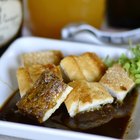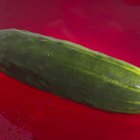
Jupiterimages/Comstock/Getty Images
A good way to add a distinctive flavor to home-cooked dishes is to use seasoned, or flavor-infused, oils, particularly olive oils. Although olive oil can become rancid sooner than other oils, it holds the seasonings and flavors well. By putting it in smaller bottles or jars, you can give seasoned olive oil to friends as a gift and help preserve the integrity of the oil. Infused olive oil can be used in most sauces as well as stir fries or as a drizzle.
Making A Selection
Select herbs based on the flavors you’re trying to achieve as well as those that combine well. Thyme and rosemary are a good combination, as are garlic and rosemary. Rosemary and basil also are good together. A variety of peppercorns goes well with anything. Other herbs , such as sage, work well alone. Also select a good quality olive oil. Virgin and extra virgin are most flavorful.
Decide whether to use fresh or dried herbs. Fresh herbs are more flavorful, while seasoned olive oils made using dried herbs have a longer shelf life.
Rinse the herbs gently, if using fresh herbs, taking care not to tear the leaves. Blanch enough leaves to fill about a quarter of the container for about three minutes. Strain and put into cold water for several seconds to seal in the color and flavor. If using leafy herbs, such as basil, roughly chop them. Sprigged herbs should be left whole. Pat the herbs dry.
Place fresh herbs, garlic, chilis, or other selections about a quarter of the way up in the sterile container and fill with olive oil. Seal. If using dried herbs, put about herbs in about ¼ of the container and then fill will with extra virgin olive oil.
Allowing the oil to set for one month will produce a stronger flavor. Once the oil is infused, typically 10 days to one month, remove solid fruit, chilis or garlic cloves by either straining the oil through a cheese cloth-lined strainer or funnel or by spooning them out.
Related Articles

How to Make Organic Shampoo & ...

How to Make Organic Shampoo at Home

How to Infuse Grappa

How to Make Balsamic Vinegar Olive Oil ...

Can I Put Fresh Chopped Basil in Store ...

How to Eat Fresh Oregano Leaves

How to Store and Freeze Sundried ...

How to Make Warming Body Oil
How to Pickle Without Vinegar
Substitutes for Alum in Pickling

How to Make Basil Oil

Ideas for a Sunshine Basket

How to Make Pickled Shallots

How to Make Pickle-Infused Vodka

What Herbs Go With Veal Chops?

How to Rehydrate Dried Herbs

How to Convert Sour Pickles to Sweet ...

How to Process & Seal Hot Sauce Bottles

How to Use Dill Weed

How to Blanch, Peel, & Freeze Whole ...
References
Writer Bio
Allyson Ash has worked in journalism for more than 20 years, covering topics from food to health care to entertainment. She has been published in a variety of newspapers, including the "Dallas Morning News," and on various websites.
Photo Credits
Jupiterimages/Comstock/Getty Images